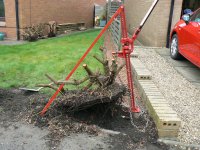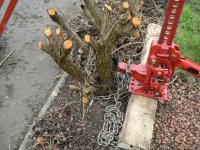About a couple of days ago, in the "what's made you grumpy today" thread, jimboy mentioned he'd found a crack in his sink and was bemoaning the fact that that was "another job to do" I then commented that the recent winds caused a number of fence posts on the 20 something year old fencing around my back garden to break off at ground level - rotten with age - and that I'd be having to renew them when some better weather arrives.
This morning I was watching a chap further up our street, from my bathroom window, who obviously has the same problem. He was trying to dig out the concrete "blob" into which what's left of the post is still fixed. He seemed to be expending a great deal of energy digging furiously but wasn't having much impact on the problem. I've just been back upstairs to swap over my book (doing a lot of reading at this time) looked out the window and he has managed to extract the "blob" but has left himself with a crater which wouldn't have been out of place in the W.W.1 trenches! He's now left himself with a real problem as to how to support the new post.
So I'm sitting here (don't do "sat here") reflecting on some of my earlier attempts at this - I've done a fair bit of "amateur" fencing especially when I was in charge of my disabled gardeners - and, over the years, I think I've evolved a good way of doing it. Thought it might interest the more practical minded DIYers on here? and maybe some of you can lend me a few hints for my upcoming renewal of the ones that have snapped off in my garden.
My earlier attempts always, conventionally, involve using spades, other digging tools and long metal bars to lever with. The problem with this method, as the chap up the road has found, is that you end up having to dig earth away from around the concrete "slug" to get it to release it's hold in the hole. The concrete slug behaves somewhat like the cork in a bottle so you need to dig quite a goodly amount of the surrounding earth away to break the suction before the slug will move. Then you've got to lever the slug - often far too heavy for one person to lift - up out of the hole and so even more damage is done to the hole.
I decided to look for some way of applying a pull to the slug without having to dig away so much of the surrounding earth and decide to try a "Farm Jack" - I'd been looking for an excuse to buy one for years! In the end I decided to buy the best quality one I could find and bought this one, which was on an offer at the time: https://www.paddockspares.com/pm684-4ft-hi-lift-jack-all-cast.html and it's a really good and robust piece of kit with all the parts available separately if I ever break it.
The idea was to dig round the top of the slug until I could loop either a chain or my engine sling around it and then just pull it out. The first time I tried it I couldn't stop the jack falling over - the forces involved tend to pull the jack over and you just can't resist with the human body. so I welded up an "A" frame which you can see in some of the illustrations to follow. Now with the jack secure the concrete crumbled before any movement could be seen and it was then that I fully appreciated how much suction there is due to the slug being such a good fit into it's hole. Before my next attempt I procured (inherited) a very stout, 5 ft long, "podgering" bar and fell heir to a long length of 1 inch section Rebar one end of which I welded a piece of stout "T" section to and sharpened a chisel point on the other. Here is a picture of the "A" frame, Jack, Rebar, Podgering bar and chain:

So next I tried ramming one of the bars down the side of the slug and violently wiggled it about. Then did the same on the other side and, just for good measure, did the same on the sides at right angles to that (ie, loosened on 4 sides) Now with the chain wrapped round the top of the slug, and the slug itself loosened in the hole so there is no suction effect, the jack was able to pull the slug cleanly up out of the hole, leaving a nice clean hole, not much bigger than the slug, into which the new post and concrete can be dropped.
Just to illustrate the jack in action with it's "A" frame, here's some pictures of it being used to pull up my neighbour's front hedge (he cut the tops off first):


I've also found a very satisfactory and quick way to dig post holes. Having for many years dug a number of post holes with a digging bar and a small headed spade, and suffered the bad back and frustration of it - anyone who's dug them this way will know - I finally decided to buy a proper post hole digger. I've seen them at the bottom of workies holes in the road and I must have looked at these hundreds of times in garden centres, hardware shops, etc and always thought, "hmmm, bit pricey? Probably won't use it that often. Think I'll just carry on with my spade". Then a professional gardener I'd met told me to just buy one and I wouldn't regret it. He also said to buy one with glass fibre handles as the wooden ones are more easily broken. If you tend to be a bit ham fisted you need to know about this. These digging tools have long handles so you can reach the bottom of the hole without bending. NOT so you can apply enormous leverage to the soil you are trying to remove from the hole. If you apply too much pressure to the handles they will snap! I like Spear and Jackson's "Neverbend" range so bought this: http://www.anything4home.co.uk/engl...digger-with-neverbend-fibreglass-handles.html and it's been a good purchase.
The post hole digger gives you a lovely "tight" vertical sided hole which then needs only a minimum of concrete to support the post:

I found though that it's a bit hard going when the ground is virgin and compacted. Then, in an unusual moment of brilliance I realized that my hand cultivator (which is a generic copy of the "Garden Claw": https://www.amazon.co.uk/Garden-Claw-GC-820-06-Cultivator/dp/B0012ZGGOG) could be used to loosen the soil in a circle exactly the same diameter as that needed by the post hole digger. If you look at the picture of the post hole digger and the hole it makes (see earlier) you can also see my "Claw" in the picture. So to dig a "perfect" hole first centre the claw where you want the hole to be and rotate it a few turns 'till the soil is loose. Now pick up the hole digger and with the handles pushed together - so spade blades apart - plunge the blades into the earth. gently but firmly pull the handles apart enough to grip the soil between the blades and lift out of the hole. Two or three "grabs" should clear the loosened earth so go back in again with the claw and loosen some more. Back in with the post hole digger and lift the soil out. Keep doing this till your hole is deep enough. I'm usually doing 6 ft high fencing so using 8 ft posts sunk 2 ft in the ground. (forget about 3 inch posts by the way 4x4 inch posts last much longer.)
Here's some pics of the fencing I did at my older boys house shortly after he bought it.



We struck lucky with the preparation. The previous fencing was 3x3 inch posts holding up some really "nasty" very cheap panels. Starting at the house we pulled 3 concrete "slugs" from the ground and then realized that the centre distances on the new "scratch built" fence were going to be slightly longer than the 6 ft panels (dictated by the length of the horizontal spars) so we didn't need to dig up any of the other "slugs". That made things much easier. When I really got going I found I could dig one post hole in about 15 minutes or so depending on the ground and have the post centred and concreted in within another 15. Then a wee rest and on to the next. We had all the posts in and concreted with most of the spars installed on the first day and the rest of the spars and most of the vertical planks on the second. Completely finished, gravel raked back, turf relayed, and all tidied up before lunch on the third.
Hope you all found this a nice wee distraction and maybe useful too. Anyone else got any tips? Won't be long 'till I'm having a go at those broken ones in my own back garden
This morning I was watching a chap further up our street, from my bathroom window, who obviously has the same problem. He was trying to dig out the concrete "blob" into which what's left of the post is still fixed. He seemed to be expending a great deal of energy digging furiously but wasn't having much impact on the problem. I've just been back upstairs to swap over my book (doing a lot of reading at this time) looked out the window and he has managed to extract the "blob" but has left himself with a crater which wouldn't have been out of place in the W.W.1 trenches! He's now left himself with a real problem as to how to support the new post.
So I'm sitting here (don't do "sat here") reflecting on some of my earlier attempts at this - I've done a fair bit of "amateur" fencing especially when I was in charge of my disabled gardeners - and, over the years, I think I've evolved a good way of doing it. Thought it might interest the more practical minded DIYers on here? and maybe some of you can lend me a few hints for my upcoming renewal of the ones that have snapped off in my garden.
My earlier attempts always, conventionally, involve using spades, other digging tools and long metal bars to lever with. The problem with this method, as the chap up the road has found, is that you end up having to dig earth away from around the concrete "slug" to get it to release it's hold in the hole. The concrete slug behaves somewhat like the cork in a bottle so you need to dig quite a goodly amount of the surrounding earth away to break the suction before the slug will move. Then you've got to lever the slug - often far too heavy for one person to lift - up out of the hole and so even more damage is done to the hole.
I decided to look for some way of applying a pull to the slug without having to dig away so much of the surrounding earth and decide to try a "Farm Jack" - I'd been looking for an excuse to buy one for years! In the end I decided to buy the best quality one I could find and bought this one, which was on an offer at the time: https://www.paddockspares.com/pm684-4ft-hi-lift-jack-all-cast.html and it's a really good and robust piece of kit with all the parts available separately if I ever break it.
The idea was to dig round the top of the slug until I could loop either a chain or my engine sling around it and then just pull it out. The first time I tried it I couldn't stop the jack falling over - the forces involved tend to pull the jack over and you just can't resist with the human body. so I welded up an "A" frame which you can see in some of the illustrations to follow. Now with the jack secure the concrete crumbled before any movement could be seen and it was then that I fully appreciated how much suction there is due to the slug being such a good fit into it's hole. Before my next attempt I procured (inherited) a very stout, 5 ft long, "podgering" bar and fell heir to a long length of 1 inch section Rebar one end of which I welded a piece of stout "T" section to and sharpened a chisel point on the other. Here is a picture of the "A" frame, Jack, Rebar, Podgering bar and chain:

So next I tried ramming one of the bars down the side of the slug and violently wiggled it about. Then did the same on the other side and, just for good measure, did the same on the sides at right angles to that (ie, loosened on 4 sides) Now with the chain wrapped round the top of the slug, and the slug itself loosened in the hole so there is no suction effect, the jack was able to pull the slug cleanly up out of the hole, leaving a nice clean hole, not much bigger than the slug, into which the new post and concrete can be dropped.
Just to illustrate the jack in action with it's "A" frame, here's some pictures of it being used to pull up my neighbour's front hedge (he cut the tops off first):


I've also found a very satisfactory and quick way to dig post holes. Having for many years dug a number of post holes with a digging bar and a small headed spade, and suffered the bad back and frustration of it - anyone who's dug them this way will know - I finally decided to buy a proper post hole digger. I've seen them at the bottom of workies holes in the road and I must have looked at these hundreds of times in garden centres, hardware shops, etc and always thought, "hmmm, bit pricey? Probably won't use it that often. Think I'll just carry on with my spade". Then a professional gardener I'd met told me to just buy one and I wouldn't regret it. He also said to buy one with glass fibre handles as the wooden ones are more easily broken. If you tend to be a bit ham fisted you need to know about this. These digging tools have long handles so you can reach the bottom of the hole without bending. NOT so you can apply enormous leverage to the soil you are trying to remove from the hole. If you apply too much pressure to the handles they will snap! I like Spear and Jackson's "Neverbend" range so bought this: http://www.anything4home.co.uk/engl...digger-with-neverbend-fibreglass-handles.html and it's been a good purchase.
The post hole digger gives you a lovely "tight" vertical sided hole which then needs only a minimum of concrete to support the post:

I found though that it's a bit hard going when the ground is virgin and compacted. Then, in an unusual moment of brilliance I realized that my hand cultivator (which is a generic copy of the "Garden Claw": https://www.amazon.co.uk/Garden-Claw-GC-820-06-Cultivator/dp/B0012ZGGOG) could be used to loosen the soil in a circle exactly the same diameter as that needed by the post hole digger. If you look at the picture of the post hole digger and the hole it makes (see earlier) you can also see my "Claw" in the picture. So to dig a "perfect" hole first centre the claw where you want the hole to be and rotate it a few turns 'till the soil is loose. Now pick up the hole digger and with the handles pushed together - so spade blades apart - plunge the blades into the earth. gently but firmly pull the handles apart enough to grip the soil between the blades and lift out of the hole. Two or three "grabs" should clear the loosened earth so go back in again with the claw and loosen some more. Back in with the post hole digger and lift the soil out. Keep doing this till your hole is deep enough. I'm usually doing 6 ft high fencing so using 8 ft posts sunk 2 ft in the ground. (forget about 3 inch posts by the way 4x4 inch posts last much longer.)
Here's some pics of the fencing I did at my older boys house shortly after he bought it.



We struck lucky with the preparation. The previous fencing was 3x3 inch posts holding up some really "nasty" very cheap panels. Starting at the house we pulled 3 concrete "slugs" from the ground and then realized that the centre distances on the new "scratch built" fence were going to be slightly longer than the 6 ft panels (dictated by the length of the horizontal spars) so we didn't need to dig up any of the other "slugs". That made things much easier. When I really got going I found I could dig one post hole in about 15 minutes or so depending on the ground and have the post centred and concreted in within another 15. Then a wee rest and on to the next. We had all the posts in and concreted with most of the spars installed on the first day and the rest of the spars and most of the vertical planks on the second. Completely finished, gravel raked back, turf relayed, and all tidied up before lunch on the third.
Hope you all found this a nice wee distraction and maybe useful too. Anyone else got any tips? Won't be long 'till I'm having a go at those broken ones in my own back garden
Last edited:

